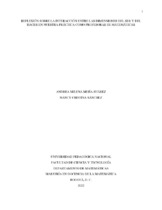Reflexión sobre la interacción entre las dimensiones del ser y del hacer en nuestra práctica como profesoras de matemáticas.
Citación
Fecha
2022Autor
Mejía Suárez, Andrea Milena
Sánchez, Nancy Cristina
Director / Asesor / Tutor
Salazar Amaya, Claudia
Palabras claves
Identidad del profesor
Dominio afectivo
Narrativa autobiográfica
Quehacer docente
Ética del profesor
Metadatos
Mostrar el registro completo del ítemResumen
Esta investigación se centra en identificar algunos aspectos de la identidad docente de las autoras de este estudio a través del análisis de los elementos que constituyen sus dimensiones del Ser y del Hacer, para interpretarlos e identificar sus interrelaciones e incidencia en sus prácticas como profesoras de matemáticas. Se ubica en un enfoque fenomenológico, a partir de una perspectiva de investigación narrativa, en la cual se usan las narrativas autobiográficas como estrategia investigativa para reconocer las subjetividades de las autoras e identificar los elementos constitutivos de su Ser, vistos desde el dominio afectivo, además de comprender los componentes del Hacer, a partir de sus modalizaciones (querer, deber, saber y poder). Los resultados de este estudio permiten reconocer algunos rasgos característicos de las dimensiones del Ser y del Hacer que configuran la identidad de las profesoras además de revelar algunos elementos para entender la relación dialógica que se da entre estas dos dimensiones.
Abstract
This research focuses on identifying some identity teacher’s aspects of the authors of this study through the analysis of the elements that constitute their dimensions of Being and Doing, to interpret them and identify their interrelation and incidence in their practices as mathematics teachers. The research is within a phenomenological approach, from a narrative inquiry perspective, in which autobiographical narratives are used as a investigative strategy to recognize the subjectivities of the authors and identify the constitutive elements of their Being dimension, seen from the affective domain, as well as to understand the components of Doing, from its modalizations (wanting, having to, knowing and being able). The results of this study allow us to recognize some characteristic features of the dimensions of Being and Doing that configure the identity of the teachers, as well as revealing some elements to understand the dialogic relationship that exists between these two dimensions.
Editorial
Universidad Pedagógica Nacional
Programa académico
Maestría en Docencia de la Matemática

